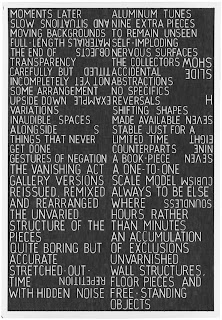Joachim Koester, My frontier is an endless wall of points (after the mescaline drawings of Henri Michaux),
Joachim Koester (°1962, Denmark) shows a mass of turbulent moving lines in his 'psychedelic documentary' about the drawings from Henri Michaux. Koester is attracted by the human body and its 'terra incognita', its subconscious. The Belgian artist Michaux (°1899 - 1984) tried to write in a pure visual way without the use of written language or meaning, influenced by mescaline and other mind-expanding substances. He wanted to explore a world that may not be possible to capture in words.
Joachim Koester, My frontier is an endless wall of points (after the mescaline drawings of Henri Michaux),
Joachim Koester, Maybe One Must Begin with Some Particular Places,
Smak, Gent, till 2013, March 10





.jpg)
.jpg)








